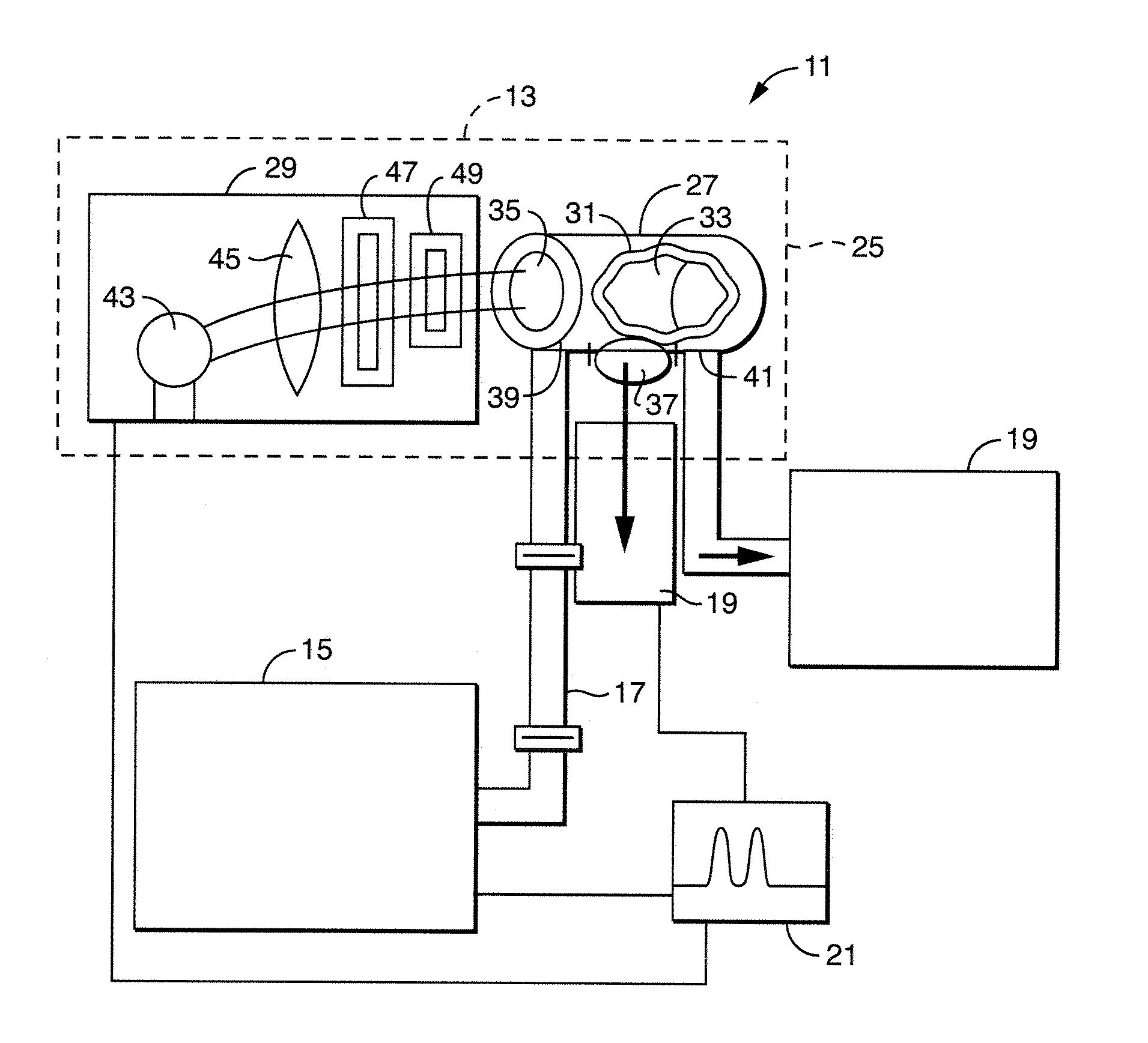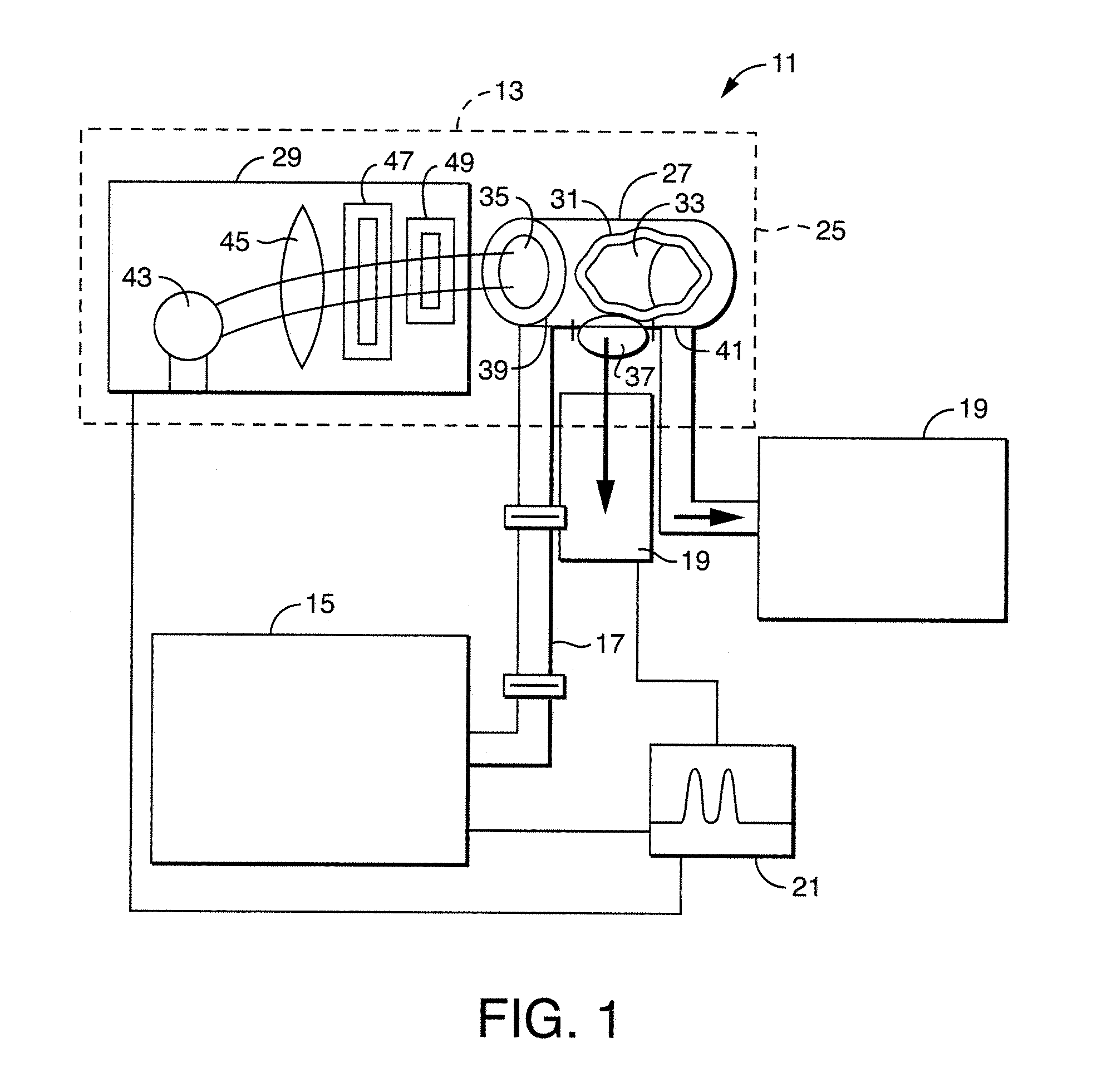Apparatus and methods for performing photoreactions and analytical methods and devices to detect photo-reacting compounds
a technology of photoreaction and apparatus, applied in the field of photoreaction, can solve the problems of time-consuming and reagent-intensive tests, toxic to humans and most animals, and aflatoxins are toxic to humans and animals
- Summary
- Abstract
- Description
- Claims
- Application Information
AI Technical Summary
Benefits of technology
Problems solved by technology
Method used
Image
Examples
example 1
Optimum Excitation and Emission Wavelengths of Aflatoxin Analysis
[0059]The excitation wavelength was 365 nm set in light source 29 for all five of the aflatoxins in this work. The 365 nm excitation wavelength coincides with the strong mercury emission line from the Hg—Xe lamp. The emission wavelength was 456 nm for the G and 434 nm for the B and M aflatoxins. These wavelengths were chosen based upon excitation and emission scans of solutions of G1 and B1.
[0060]FIGS. 3 and 4 depict the emission and excitation spectra for 1 ppb solutions of G1 and B1 aflatoxins along with the baseline emission spectra for the 64 / 18 / 18 solvent mixture of water / methanol / acetonitrile at the stated conditions. FIG. 3 depicts the C1 aflatoxin with emission and excitation scans. The Diff curve is the difference between the Em spectra and the 64 / 18 / 18 baseline spectra. The difference is the emission spectra of the aflatoxin. The excitation curves are included to show 365 nm excitation wavelength is the best ...
example 2
Residence or Dwell Time Studies
[0062]A study was undertaken on the effect of residence time of the aflatoxins in the chamber 33. Since photoreactions depend on the number of photons encountering the molecules and the output of lamp 43 is fixed, the molecules can be exposed to more photons as they flow through the chamber 33 by lowering the flowrate. The effect of the solvent mixture composition was also evaluated. The method presently uses a 64 / 18 / 18 mixture of water / methanol / acetonitrile. Table 1 shows the solvent compositions tested for each of the aflatoxins.
[0063]The flow rate was step changed during the running of a given aflatoxin in a given solvent composition. Flow rates used were 1, 0.5, 0.25, 0.1 and 0.05 ml / minute. The fluorescence signal was monitored at the different flow rates for each aflatoxin and solvent composition.
[0064]The results for 1 ppb solutions of the aflatoxins in the various solvent compositions are presented in FIGS. 5 through 9 in the order of elution a...
example 3
Wavelength Effect on Photoconversion and Signal
[0071]This example involved the passing of a constant composition solution of an aflatoxin through two detectors in series.
[0072]In the first detector, the excitation wavelength was changed between 241 m, 313 nm, 365 nm and 405 nm. A light-shuttering mechanism was interposed between the light source 29 and first window 35. With the shutter in the ‘open’ position, the excitation light was allowed to pass into chamber 33; photons were prevented from reaching the solution in the ‘closed’ position.
[0073]A second fluorescent detector [not shown] was used to monitor the outflow from chamber 33. This detector employed an excitation wavelength of 365 nm and emission wavelengths of 434 nm for B1 and 456 nm for G1 solutions. Typical results are presented in Table 3 below; an example of one of the runs, 100 ppb G1 at 0.5 ml / minute, used to generate this data is shown in FIG. 12. It may be seen in FIG. 12 that the signal with the shutter open is al...
PUM
| Property | Measurement | Unit |
|---|---|---|
| excitation wavelength | aaaaa | aaaaa |
| excitation wavelength | aaaaa | aaaaa |
| excitation wavelength | aaaaa | aaaaa |
Abstract
Description
Claims
Application Information
 Login to View More
Login to View More - R&D
- Intellectual Property
- Life Sciences
- Materials
- Tech Scout
- Unparalleled Data Quality
- Higher Quality Content
- 60% Fewer Hallucinations
Browse by: Latest US Patents, China's latest patents, Technical Efficacy Thesaurus, Application Domain, Technology Topic, Popular Technical Reports.
© 2025 PatSnap. All rights reserved.Legal|Privacy policy|Modern Slavery Act Transparency Statement|Sitemap|About US| Contact US: help@patsnap.com



